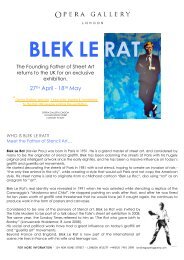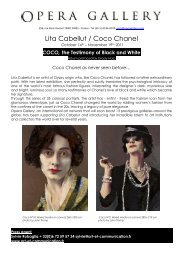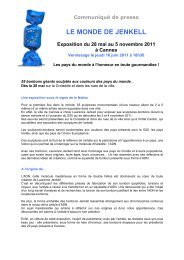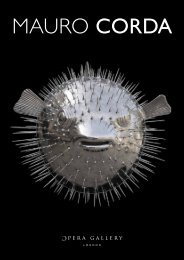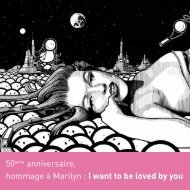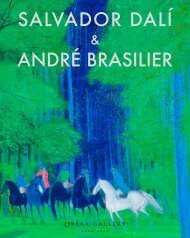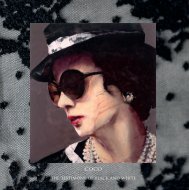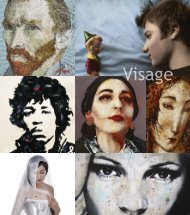Download - Opera Gallery
Download - Opera Gallery
Download - Opera Gallery
Create successful ePaper yourself
Turn your PDF publications into a flip-book with our unique Google optimized e-Paper software.
Infinity in the Universe of<br />
Yayoi<br />
KUSAMA
An associated<br />
project of<br />
Infinity in the Universe of<br />
Yayoi<br />
KUSAMA<br />
“I gradually feel myself under the spell of the accumulation and repetition in my nets which<br />
expand beyond myself, and over the limited space of canvas, covering the floor, desks and<br />
everywhere.”<br />
Yayoi Kusama, Yayoi kusama: Early Drawings, from the Collection of Richard Castellane.<br />
The infamous Japanese master Yayoi Kusama has won an unprecedented and well-deserved<br />
recognition this year being honored with major Museum retrospective show travelling<br />
from the Museo Nacional Centro De Arte Reina Sofía in Madrid to the Centre Pompidou<br />
in Paris, via its current display in The Tate Modern in London. The show will finish in the<br />
Whitney Museum in New York later this year.<br />
Kusama is one of Japan’s best-known living artists and her pioneering work spans over<br />
six decades spreading from Japan to the United States and Europe. Her prolific portfolio<br />
includes drawing, painting, sculpture, performance, installation art, movie directing, novel<br />
and poem writing. Considered by some members of the New York scene to be “too beautiful,<br />
too crazy, too powerful”, Kusama became an art force not to be ignored.<br />
Celebrating her international success and everlasting popularity, we are proud to present<br />
you a collection of Kusama’s works with various pieces including paintings and limited edition<br />
prints highlighted by a 2.6 meter sculpture of polka dot girl titled Kei-Chan.<br />
Chosen as an associated project of Le French May Arts Festival supported by the Consulate<br />
General of France in Hong Kong and Macau, the exhibition celebrates an exceptional<br />
timing of arts and culture blossoming in Hong Kong.<br />
We invite you to indulge in the infinity that is the universe of Kusama.<br />
Shirley YablonSKY<br />
Director<br />
<strong>Opera</strong> <strong>Gallery</strong> Hong Kong<br />
Gilles Dyan<br />
Founder and Chairman<br />
<strong>Opera</strong> <strong>Gallery</strong> Group 03<br />
© Yayoi Kusama
Yayoi<br />
KUSAMA<br />
Follow the vision<br />
These works were part of a major exhibition,<br />
Modern Japanese Paintings, organized by<br />
the influential Bratat <strong>Gallery</strong>, New York.<br />
Born in 1929 in the historic city of Matsumoto,<br />
Japan, Yayoi Kusama showed signs<br />
Kusama’s work at that time was strongly<br />
of a powerful artistic personality from a very<br />
influenced by the experimental mood that<br />
young age. Following her studies at the<br />
reigned in the city during the post-war years.<br />
Kyoto Municipal School of Arts & Crafts,<br />
Kusama exhibited her first Nihonga pain-<br />
During her time in New York, Kusama met<br />
tings (“Cat”) which were selected for the<br />
and collaborated with many famous artists<br />
First Nagano Prefecture Art Exhibition. She<br />
like Mark Rothko, sculptor Eva Hesse (who<br />
was just 19 years old.<br />
later became a close friend) and, of course,<br />
with partner and friend Donald Judd, who<br />
In 1952, after a successful exhibition at the<br />
would assist her in so many artistic projects<br />
First Community Center, while being trea-<br />
for years to come. Judd bought “Infinity Nets”<br />
ted for obsessive neurosis, her paintings<br />
(1959), an iconic, ground-breaking piece<br />
caught the eye of some of her psychiatrists.<br />
that would later sell at auction in 2008 for<br />
Dr. Nishimaru recognized her talent and<br />
more than 5.7M USD$ (and this, despite the<br />
proposed to organize an exhibition in the<br />
global economic crisis). The sale positioned<br />
USA, but Kusama’s family was unfortuna-<br />
Kusama as the world’s most expensive<br />
tely against such a project.<br />
female artist to date.<br />
In 1954, at the age of 25, Kusama’s first<br />
As of 1960, both Kusama and Mark Rothko<br />
solo exhibition in Shirokiya Department<br />
showed growing interest in the European<br />
Store, Tokyo, met with great success.<br />
avant-garde movement. Indeed, they were<br />
the only two artists residing in the US to be<br />
One year and three additional solo exhibi-<br />
included in Monochrome Malerei, an inter-<br />
tions later (all in Tokyo), Kusama’s works<br />
national collection of contemporary abstract<br />
finally made it to America as part of the<br />
art at Städtisches Museum in Leverkusen,<br />
International Watercolor Exhibition at the<br />
Germany. This exhibition greatly influenced<br />
04<br />
Brooklyn Museum, New York.<br />
In 1958, Kusama settled down in New York<br />
and started exploring what she would call<br />
her “Infinity Nets” paintings: large canvases<br />
the artistic careers of friends such as<br />
Franck Stella, Lucio Fontana and the Dutch<br />
Nul Group.<br />
Pumpkin<br />
1998<br />
05<br />
covered with a hypnotic array of little dots.<br />
Bronze, edition of 100, 28 x 27 x 27 cm
With respect to dots, Kusama declared on<br />
Kusama was often invited to appear on<br />
numerous occasions:<br />
Japanese television. Such moments promoted<br />
her fame, while leaving impressions<br />
“My life is a Dot lost among thousands<br />
Her encounter with the American sculptor<br />
that would play an important role in her future<br />
It is precisely this rebirth period, from 1981<br />
of other dots.”<br />
and experimental filmmaker Joseph Cornell<br />
literary works.<br />
to the present, which is highlighted in the<br />
would strongly influence her creative pro-<br />
exhibition organized by <strong>Opera</strong> <strong>Gallery</strong>,<br />
Kusama Yayoi is definitely one of the<br />
cess. Cornell’s fantastic imagination can be<br />
The 70s were, however, a dark period<br />
Hong Kong.<br />
world’s most distinctive and influential mul-<br />
Her European travels and exhibitions<br />
characterized by the assembly of lost and<br />
in Kusama’s creative life. Following the<br />
In that same year, both the Tokyo and Kyoto<br />
tidisciplinary conceptual artists. After 70<br />
inspired the artist’s “Accumulation” series:<br />
found objects, making him a pioneer in this<br />
death of her partner Joseph Cornell, and<br />
Modern Art Museums included Kusama in<br />
years of active practice, her works continue<br />
with touches of absurdity and exuberance<br />
type of artistic expression. André Breton<br />
shortly thereafter of her own father,<br />
a list of the most important painters of the<br />
to amaze us, with such an incredible feeling<br />
covering ordinary objects and furniture with<br />
would say: “he enjoys an experience that<br />
Kusama’s health (psychic but also physical),<br />
1960s, with her works highlighted in an<br />
of creative power radiating from her works.<br />
phallic protuberances. This series was ac-<br />
upsets the conventions of how we use<br />
started to deteriorate. She created new<br />
exhibition called The 1960s: A Decade of<br />
claimed by famous artists like Oldenburg,<br />
objects”. Their relationship illuminated and<br />
collages (“Message of Death from Hades”)<br />
Change in Contemporary Japanese Art.<br />
Started in 2011, and scheduled to continue<br />
Morris, Warhol, Lichtenstein, Wesselmann,<br />
enriched Kusama’s private life, and conti-<br />
which were exhibited in Tokyo’s Nishimura<br />
It was, in fact, this total reappraisal of Kusama<br />
throughout 2012, Yayoi Kusama’s solo<br />
or feminist culture critic Lucy Lippard (who<br />
nued until Cornell’s death in 1973.<br />
<strong>Gallery</strong>. This eccentric exhibition, so em-<br />
as an artist, by her own country and by the<br />
exhibition has been hosted by the most<br />
proclaimed Kusama as the precursor of<br />
otionally striking, grabbed the attention of<br />
international art world, that gave a new im-<br />
preeminent contemporary art museums<br />
Eccentric Abstraction).<br />
From 1965, Kusama shared a studio with<br />
art critic Akira Tatehata, who would play an<br />
pulse to her creativity.<br />
worldwide - in Madrid, Paris, London and<br />
well-known Japanese artist On Kawara, who<br />
important role in Kusama’s future.<br />
New York.<br />
would become one of the most important<br />
From 1981, numerous and remarkable<br />
conceptual artists in Asia. In the same year,<br />
After a few short stays in Tokyo, and, more<br />
retrospectives would contribute to her<br />
In response to Frances Morris, the curator<br />
Kusama produced her famous “Infinity<br />
importantly, after a suicide attempt, exhaus-<br />
international reputation, culminating with<br />
of Tate Modern show in London, Kusama said:<br />
Mirror Room - Phalli’s Field” (or “Floor Show”).<br />
ted, Kusama decided to return to Japan for<br />
the famous solo exhibition Kusamatrix, or-<br />
Towards the end of the 60s, Kusama began<br />
good. As of 1977, she became a permanent<br />
resident of a psychiatric clinic in Tokyo. Un-<br />
ganized by the Mori Art Museum, Tokyo in<br />
2004. The exhibit attracted more than half a<br />
Dots 1999, acrylic on canvas, 33,3 x 24,2 cm<br />
“I have a flood of ideas in my mind…<br />
I just follow my vision”.<br />
her first “happenings’’ (public theater):<br />
der such depressing conditions, she edited<br />
million visitors.<br />
The show combines a variety of works from<br />
poems and an art album (“7”). As of this<br />
Kusama’s eclectic and rich pallet, including<br />
Galina COULOT<br />
“Obliterate your personality with polka<br />
sadly remarkable year, her artistic creativity<br />
In 1993, Kusama was selected to represent<br />
the famous pumpkins, infinity nets and dots<br />
Art Historian critic<br />
dots<br />
declined and she remained in the shadows<br />
Japan at the Venice Biennial. She chose one<br />
paintings.<br />
Become one with eternity<br />
until 1981.<br />
of her main subjects, pumpkins, to create<br />
Become part of your environment…<br />
the installation “Mirror Room - Pumpkins”.<br />
Kusama’s obsession with dots from such<br />
Flames 1990, acrylic on canvas, 53 x 45,5 cm<br />
Take off your clothes<br />
Forget yourself<br />
This magnificent and unforgettable work<br />
again depicted the red line of her plastic<br />
a young age is probably related to the hallucinations<br />
she suffered as a child. These<br />
Make love<br />
creation, a concept comprised of accumu-<br />
famous dots of various forms, shapes and<br />
Self-distraction is the only way to peace.”<br />
lation, repetition and infinity.<br />
colours would become her trademark; for<br />
the first time in 1965, she proposed polka<br />
These slogans perfectly illustrate Kusama’s<br />
dots combined with mirrors (Phalli’s Field).<br />
artistic spirit of the period.<br />
Dots became an integral part of her “hap-<br />
06<br />
penings” or experimental movies, as an expression<br />
of her opposition to the Vietnam<br />
War. She used the visual capacity of the<br />
07<br />
dots to “break” an object by destroying the<br />
details of shape or silhouette.
08<br />
Kei-Chan<br />
2011<br />
Fiberglass reinforced plastic, metal, urethane paint, unique piece, 260 x 135 x 100 cm
10<br />
Dots<br />
1999<br />
Flames<br />
1990<br />
11<br />
Acrylic on canvas, 33,3 x 24,2 cm<br />
Acrylic on canvas, 53 x 45,5 cm
12 Necklace’s tears<br />
1988<br />
Acrylic on canvas, 31,8 x 41 cm
Waves on the lake<br />
1988<br />
Acrylic on canvas, 53 x 45,5 cm<br />
15
16<br />
Season of cannas<br />
1988<br />
Acrylic on canvas, 38 x 45,5 cm
Waves in the evening glow<br />
1988<br />
Acrylic on canvas, 45.5 x 53 cm<br />
19
20 Infinity nets<br />
1993<br />
Acrylic on canvas, 91 x 61 cm
Hat (ate)<br />
2001<br />
Acrylic on canvas, 22 x 27,3 cm<br />
23
Hat I<br />
2000<br />
Silkscreen, edition of 60 + 12 HC + 15 AP, 50 x 65 cm<br />
Hat II<br />
2000<br />
Silkscreen, edition of 60 + 12 HC + 15 AP, 50 x 65 cm<br />
24<br />
25
Pumpkins<br />
2002<br />
Limoges porcelaine, edition of 130 + 10 HC, 8,5 x 7,3 x 7,5 cm each<br />
Pumpkin<br />
1992<br />
Acrylic on canvas, 15,8 x 22,7 cm<br />
26<br />
27
Pumpkin<br />
1990<br />
Acrylic on canvas, 16 x 23 cm<br />
Pumpkins<br />
2002<br />
Limoges porcelaine, edition of 130 + 10 HC, 9 x 10 x 8 cm each<br />
28<br />
29
Pumpkin I<br />
2000<br />
Silkscreen, edition of 60 + 12 HC + 15 AP, 50 x 65 cm<br />
Pumpkin II<br />
2000<br />
Silkscreen, edition of 60 + 12 HC + 15 AP, 50 x 65 cm<br />
30<br />
31
Watermelon<br />
1983<br />
Acrylic on canvas, 38 x 45,5 cm<br />
33
34<br />
Tulipe I<br />
2000<br />
Silkscreen, edition of 60 + 12 HC + 15 AP, 65 x 50 cm<br />
Tulipe II<br />
2000<br />
Silkscreen, edition of 60 + 12 HC + 15 AP, 65 x 50 cm<br />
35
36<br />
Fruits Epsob<br />
2011<br />
Acrylic on canvas, 112 x 145,5 cm
Panier de Fruits I<br />
2000<br />
Silkscreen, edition of 60 + 12 HC + 15 AP, 50 x 65 cm<br />
Panier de Fruits II<br />
2000<br />
Silkscreen, edition of 60 + 12 HC + 15 AP, 50 x 65 cm<br />
38<br />
39
The imminent death<br />
1989<br />
Acrylic on canvas, 38 x 45,5 cm<br />
41
Papillon I<br />
2000<br />
Silkscreen, edition of 60 + 12 HC + 15 AP, 50 x 65 cm<br />
Papillon II<br />
2000<br />
Silkscreen, edition of 60 + 12 HC + 15 AP, 50 x 65 cm<br />
42<br />
43
44<br />
Bird<br />
1981<br />
Gouache, pastel, ink, paper collage and fabric collage on paper, 66 x 51,4 cm
Nest<br />
Vase<br />
46<br />
1980<br />
Pastel, felt pen and collage on paper, 65,7 x 51 cm<br />
1994<br />
Pastel, felt pen and collage on paper, 51,2 x 36,6 cm<br />
47
2-8 Wellington Street<br />
G2 F, M88<br />
Central, Hong Kong<br />
T. + 852 2810 1208<br />
hkg@operagaller y.com<br />
www.operagallery.com
An associated<br />
project of<br />
www.operagallery.com



